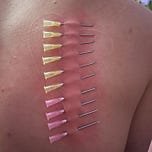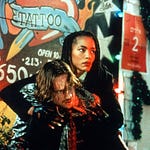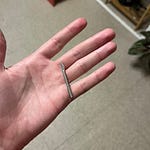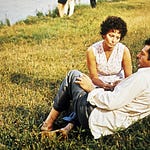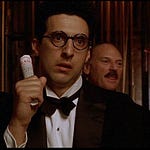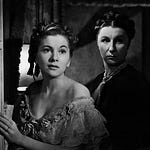Years ago, I came across an evopsych-y theory for OCD that got stuck in my brain.
Certain obsessive thoughts and compulsive behaviors, the argument went, were of use in early human societies, meaning that those who expressed them had more opportunity to reproduce and thereby pass on that genetic tendency. The clusters of characteristics that now fall under the umbrellas for hoarding1, contamination, or scrupulosity OCD2, for example—which are here and now pathologized as mental illness—actually provided a reproductive edge. Maybe today’s collectors were yesterday’s top-dog protein gatherers. Maybe obsessive cleanliness, even when existing in the absence of germ theory, staved off disease. Maybe the kind of person inclined to ritual and mystical meaning-making could be a little intense 10,000 years ago—but maybe that same person used their inclinations to help build culture that enriched social life and strengthened the collective.
More recently, I read a book about OCD that posited the above theory’s opposite. Certain newer studies suggested that OCD’s calling-card behaviors—like counting, collecting, and checking—actually predate meaning. That is, you did not learn about the danger of germs and only then, when encountering an environmental trigger that culminated in a DSM-V-able OCD, become germaphobic. Rather, your body decided that it needed to wash its hands until they bled; needed to count the stairs up to your apartment every day 13 times, at minimum, very very very important; was simply just gonna lock and unlock the front door so many times that you were late for work that day. Then your unconscious mind filled in the empty bits to give all of that activity some purpose.
Context creates the narrative, giving discrete events the reassuring structure of plot, but the compulsion never relied on a story to exist. What’s worse than needing to pray for everyone you know before you fall asleep or they will all die a fiery death? Knowing that you must go through with it despite the fact that you also know this isn’t true.
Now, listen. I don’t know much about OCD, and next to nothing of medical history, psychology, all that stuff. I have no idea which, if either, of these theories is true, or is generally accepted by the medical establishment, or even if I have accurately regurgitated them here for you.
But I can tell you which theory is more appealing to me, as a person with an interest in obsessive and compulsive behaviors, whether or not they qualify as mental illness. I like the latter notion: the idea that sometimes our bodies do things without our brains, and that for some reason—the need for internal coherence or fantasy or self-protection of some kind—our brain then decides to cover our body’s tracks. It feels godlike to make meaning from nothing, even if that meaning isn’t strictly factual (which isn’t to say that it isn’t real). Considering the frequency with which his abominations are found walking the earth, it sounds like god is often wrong, anyway, so maybe this inductive approach to suffering makes us more like him than we realize.
Needles are my sweet spot. I’ve had my fair share of bad medical experiences, but few involved needles, per se, though I did develop a brief aversion to blood draws after I was in a year-long paid study where I went in twice a week for labs. I could only count on a real phlebotomist being at the clinic 75% of the time; otherwise, I got stuck with a specialist (an OB/GYN, usually, as the study had to do with so-called “women’s health”), and MDs suck major ass when it comes to finding and tapping veins, even with me, whose veins are often complimented in that kind of scenario. I’m vain about my veins.
Anyway. When Dahlia got me into needleplay almost ten years ago, I came to it without any needle baggage. I didn’t have any latent psychic needs to address or any phobias to overcome. I did it because it’s a fairly easy, low-risk, relatively inexpensive way to be hurt and produce blood that doesn’t really scar, or even leave many marks, if you don’t want it to. And also because Dahlia likes it.
A decade later, I’ve had thousands of needles inserted into my skin by her and other people, and as with any other practice, I’ve gotten better at it. The first or second time, Dahlia only put in a handful—maybe eight, maybe just four—and they were probably 26g, or something like that (which is quite small. Standard size for blood draws is 21g, I believe). I was so high off the adrenaline that I went to another room to be alone so I could laugh. Now I can take dozens of needles at a time, sometimes quite big ones, before it starts to feel like an effort. Sometimes my top fucks me with them—which is to say, they twist and pull, yank them out then reinsert at a different angle, finding ways to make the tiny pain of broken skin feel more like a knife than a pinprick. Sometimes they do other things, like wrap me in plastic with the needles still inside and hit me with leather, as Jade and Ez did the other night.
I still get that adrenaline rush, just like the first time, but it’s rarely as strong, and it takes much more than a casual scene to induce that drug-like euphoria. Because if you want intense highs, you must first experience intense lows. That’s the deal—I don’t make the rules. You have to feel pain and fear if you want to also feel the good stuff, and I make it a point, these days, to have easy scenes as well as stressful ones. Depending on the scene, in fact, a few needles can even be a nice way to unwind before bed.
There is still an element of punishment to needleplay, because of course it hurts; but that pain is the only way in which it resembles the other kinds of discomfort that interest me. My needle scenes are the least hierarchical, with very little in the way of power exchange. There is no roleplay, no humiliation other than a little teasing, no direct lines to negative early experiences, like spanking, or raced, gendered, and classed sociocultural associations, as is necessarily the case with corporal punishment. My relationship with needles was created consensually, in adulthood among other adults in fun, sexy contexts. Now that I think about it, it links most closely with the tattoo as it’s constructed today where I am: adult, consensual, more or less amoral and apolitical, vaguely sexy, a little challenging, like running a 10k.
What I’m saying is that needles are, in a way, a blank slate for me. They do not put me in conversation with my distant past, like other aspects of SM, and the older I get, the more I appreciate and value this aspect of the experience. My body needs to regularly indulge in discomfort to be comfortable, for some reason. But what sets needles apart, as a way to fulfill that need, is that there is a minimum of psychic distress that must be undergone in the process. I want the sensation and I join others to take it. As I make and remake meaning from it, I am not fighting against an ancient narrative, fossilized by culture and neural memory. In writing my own story, I am struck, again and again, by how fragile the categories of both pain and pleasure really are.
David tweets at @k8bushofficial. Preorder their second novel, X (Catapult, 2022).
Subscribe to support GOOD ADVICE/BAD GAY, an advice series from an anonymous gay therapist who’s not afraid to hurt your feelings with the truth. (Sample an unlocked post for a taste of what you’re missing.) 100% of funds go to support a rotating selection of mutual aid and reparations projects.
Want advice? Email badgayadvice@gmail.com for a free 3-month subscription.
Noting that “hoarding” is the more common—and far more stigmatized—term for collecting OCD behaviors. I’ve used it here because it’s one that people recognize, but please using “collecting” when you can instead.
That is, if an illness of the past can be said to be an illness of the present, even provided it could be produced because of similar conditions, which it couldn’t.

